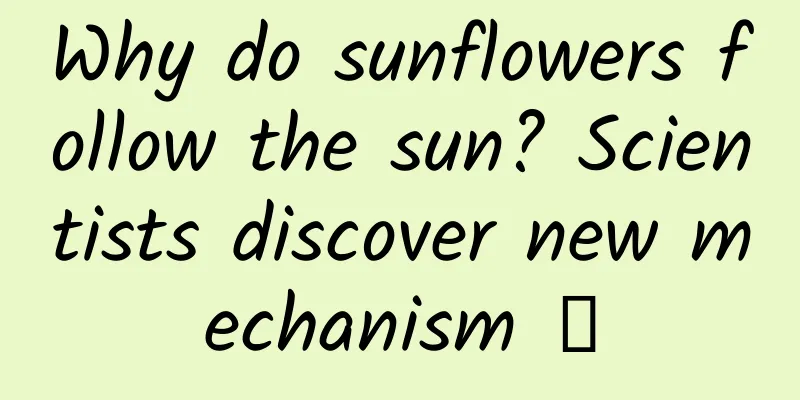Why do sunflowers follow the sun? Scientists discover new mechanism →

|
Compiled by: Gong Zixin sunflower Known for its ability to track the sun throughout the day But how does it "see" the sun? And what follows it? New research by UC Davis plant biologists, published Oct. 31 in the journal PLOS Biology, shows they use a novel mechanism that is different from what was previously thought. “This was a complete surprise,” said Stacey Harmer, a UC Davis professor of plant biology and senior author of the paper. Heliotropism and phototropism As the sun moves across the sky, the sunflower turns its face to follow the sun, then reorients itself at night to face east the next morning. This happens through a different growth pattern, with the east side of the stem growing more during the day and the west side of the stem growing more at night. This process is called heliotropism and is often considered a specialized form of phototropism. Phototropism - the ability to grow towards a light source - is one of the most characteristic growth responses of plants. Plant scientists had hypothesized that heliotropism in sunflowers is based on the same basic mechanism, controlled by a molecule called phototropin and responding to light at the blue end of the spectrum. However, the underlying mechanism of heliotropism was unclear. To better understand heliotropism, the researchers compared gene expression patterns in sunflowers grown in a controlled environment in a laboratory with those grown outdoors in field sunlight. Figure 1 Phototropism and auto-straightening response of sunflower stems Indoors, sunflowers growing directly into the light activated genes associated with phototropin. But sunflowers grown outdoors, swaying their heads in the sun, showed a completely different pattern of gene expression. There was no discernible difference in the phototropin proteins between one side of the stem and the other. Figure 2 Transcriptome analysis of sun-tracking sunflower stems However, some genes rapidly induced during phototropism, as well as genes involved in leaf shade growth response, were rapidly induced on the west side of the stem at the onset of phototropism, suggesting that red photoreceptors may play a role in sun tracking. Fig. 3 Different patterns of gene expression during phototropism and heliotropism To test the role of different photoreceptor signaling pathways in heliotropism, the researchers adjusted the light environment in which the plants initiate sun tracking. They found that blocking blue, ultraviolet, red, or far-red light with a blackout box had no effect on the heliotropism response and did not hinder the onset or maintenance of heliotropism in sunflowers in the field. Figure 4 The onset of heliotropism shows distinct transcriptional signatures and occurs under different light conditions Taken together, our results suggest that the transcriptional regulation of phototropism is distinct from that of phototropin-mediated phototropism. Both the onset and maintenance of heliotropism are resistant to changes in light quality and indicate that multiple light signaling pathways are involved in the regulation of sun tracking. "We seem to have ruled out the phototropin pathway as a possibility, but we haven't found a clear smoking gun yet," Harmer said. Next steps will look at protein regulation in plants. Data chart and reference source: |
<<: World COPD Day | Breathe freely without any obstruction
>>: Rare! Bathing can cause illness. What is "bird" disease?
Recommend
The mysterious little card in the bread bag is actually a master of mold prevention!
Have you ever wondered why there is always a smal...
Why are fruits becoming sweeter and sweeter? Is this unhealthy?
Have you noticed that fruits are getting sweeter ...
AndroidSlidingUpPanel
introduce Drag the bottom view upwards, and the b...
Can long-term coffee drinking help you lose weight? Can it help you have a bowel movement? Huaxi experts reveal 4 truths, forward and save~
Can long-term coffee drinking help you lose weigh...
2021 Jia Kun Vocabulary Tour: 6500 Compulsory Words for University Core
2021 Jia Kun Vocabulary Journey: University Core ...
School is about to start! Learn how to check children's vaccination certificates for kindergarten and school admission →
As the school season approaches, many parents are...
Will the Apple Watch be a hit?
[[129121]] Here it comes, the Apple Watch is fina...
Does water have a color? Why is swimming pool water blue?
Today's Tadpole Quiz is here! The above is @A...
ASP.NET MVC/C# development tips record.
1. When writing CSS, first replace the original c...
In order to prevent crocodiles from eating toads, scientists gave toads some "food"
Produced by: Science Popularization China Author:...
How much does it cost to make an underwear mini program on the Anyang market?
How much does it cost to produce the Anyang under...
Chinese people are not suitable for drinking milk? 85% of Chinese people are lactose intolerant? You have misunderstood for too many years!
Rumor: "Chinese people are not suitable for ...
A money-making project that passively acquires traffic: You can also earn 200 yuan a day by intercepting traffic and selling information from Douyin comments
It is not difficult to make money. You just need ...
Android 6.0 has been exposed and will be officially released in November next year
Android 5.0 was just launched not long ago, and n...
MX4 Pro proves that there is still a market for being an Apple disciple
[[123302]] The long press conference finally ende...









